What Is Abstract Art? How Artists Make Something Out of Nothing
The kind of people who wander through museums proclaiming “I could’ve made that!” love to criticize abstract art. Perhaps that’s because it’s so hard to define. What is abstract art anyway? Is it something that we can define? Let’s explore abstract art definitions through the work of Park West Gallery’s artists.
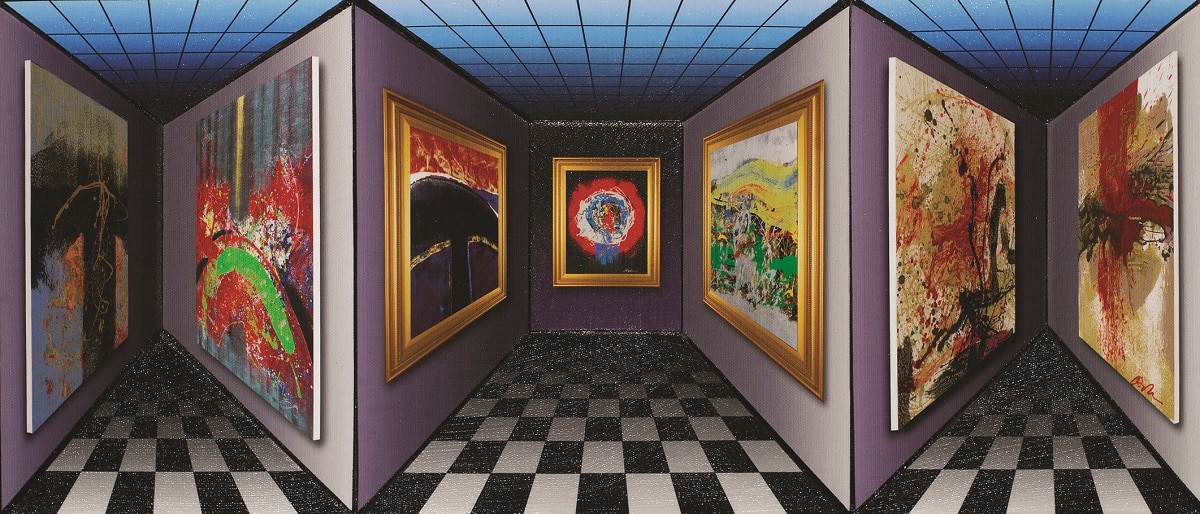
“Abstract in Motion – Art in Motion” (2011), Dominic Pangborn
In contrast to landscape paintings or detail-for-detail recreations of famous events and iconography, abstract art focuses instead on the pure visual quality of the work, allowing colors and shapes to do the talking about what an image represents. To those unfamiliar, traditional realism may seem harder to render than the abstract, but both disciplines are equally complex.
For centuries, artwork was always expected to be representational. It had to be a picture “of” something—a tree, a person, a bowl of fruit. Deeper subtext often relied on very literal interpretations of the images depicted. For example, if an artist wanted to evoke feelings of freedom, they might paint a bird, because of the visual characteristics associated with birds, like flight or wings.
An abstract artist, on the other hand, might accept the challenge to evoke those exact same feelings of freedom without showing the viewer a literal bird or any recognizable forms at all. The artist isn’t called upon to render a photorealistic rendering of a bird, but, instead, they’re forced to take their viewer on an emotional and aesthetic journey without the shorthand of the bird to rely on.
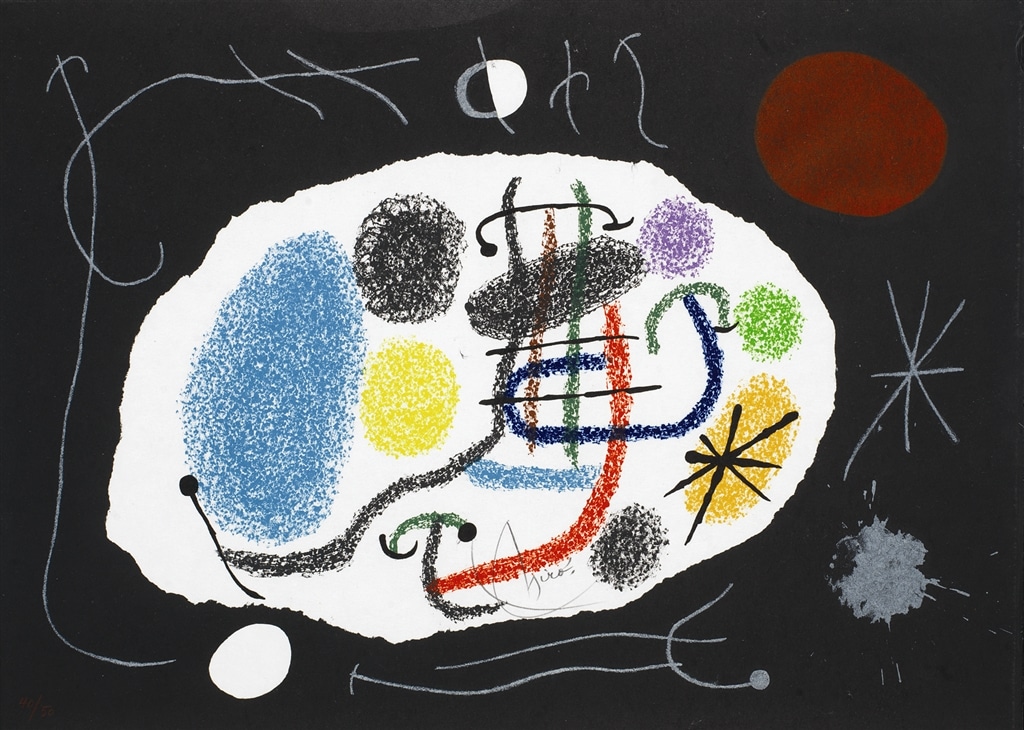
“Le Lezard aux Plumes d’Or II” (1971; m. 800), Joan Miró
This necessity for visual art to be “of” one thing or another is not expected of other art forms. Music and architecture, as examples, are commonly interpreted by the characteristics unique to them—their sonic and physical forms, respectively.
The pioneers of the abstract art movement—Wassily Kandinsky, Georges Braque, Pablo Picasso, Joan Miró, Jackson Pollock, Piet Mondrian, and Victor Vasarely, to name a few—saw this as an unfair expectation or as a betrayal of the power visual art has to convey emotions through the depiction of color and shapes alone.
They pushed themselves to transcend the classical definitions of art, exploring new subjective and non-representational spaces, and create something new.
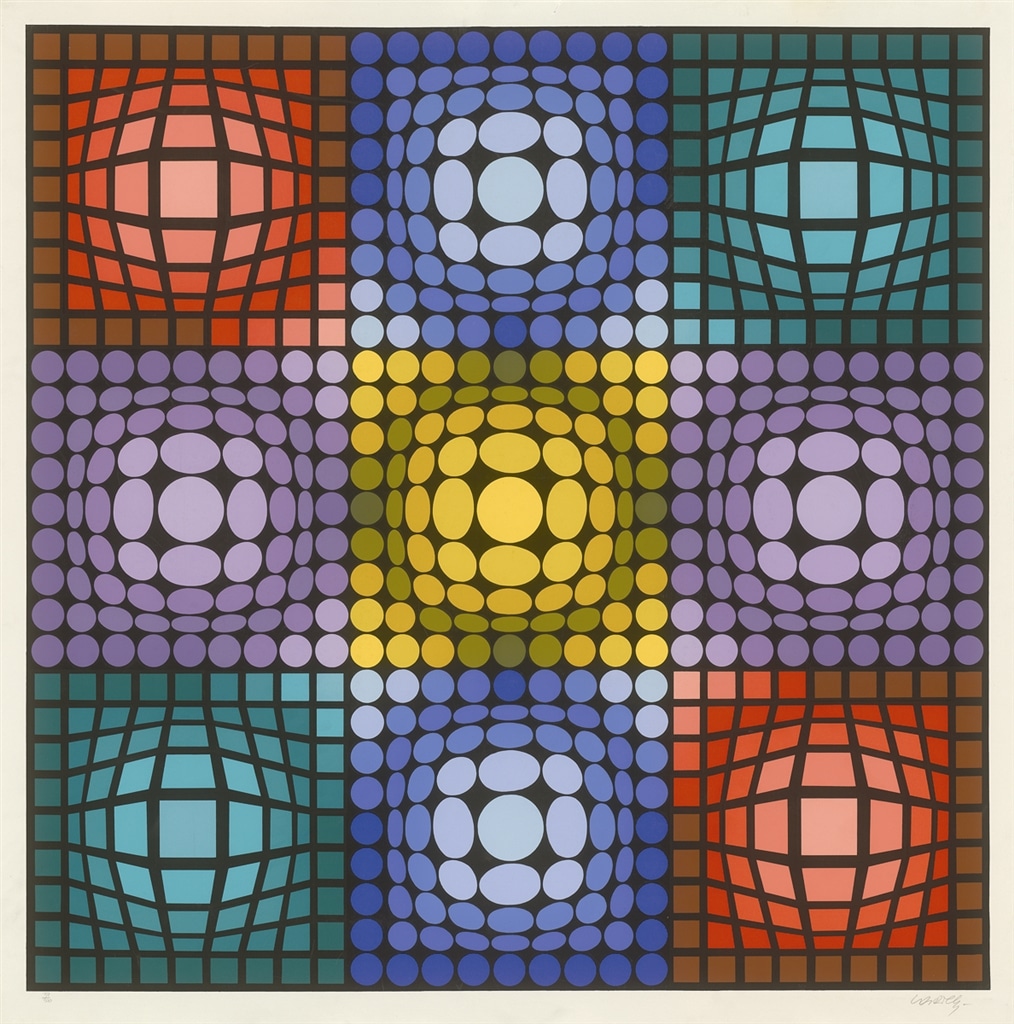
“Dyevat” (1987), Victor Vasarely
Abstract Art’s Humble Beginnings
Picasso was once quoted as saying, “As far as I am concerned, a painting speaks for itself. What is the use of giving explanations when all is said and done? A painter has only one language.” This is abstract art in a nutshell: paint on a canvas should say more than any interpretation of its “meaning” ever could.
However, when we talk about the pioneers of abstract art, we’re referring to the European artists that coined the term. The origins of abstract art actually stretch back to the dawn of human civilization. 65,000-year-old cave drawings in Spain showcase abstract horizontal and vertical lines, winding paths of dots, and unrecognizable figures captured in red ochre. This is what abstract artists attempt to recreate—an emotion freed from the human mind by color and shape.
Moving into the modern era of humanity, we see abstraction littered throughout artistic movements all over the world. Chinese ink-wash paintings of the ancient Tang Dynasty prioritize the “essence” of the image over realistic representations.
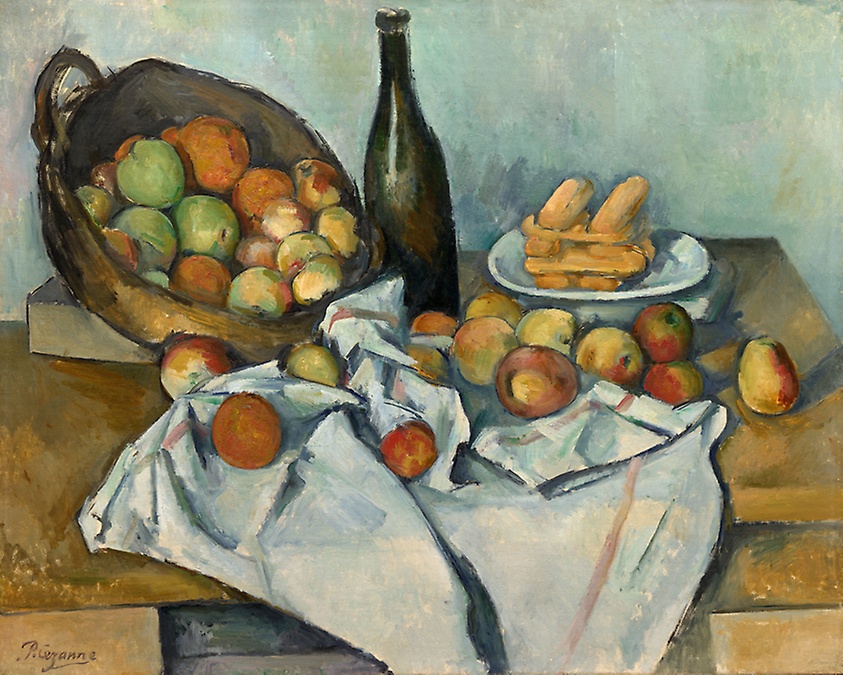
“The Basket of Apples” (c. 1893), Paul Cézanne (courtesy of The Art Institute of Chicago)
Branching off from the Impressionist desire to accurately depict light in paintings, the 19th-century Post-Impressionists, led by Paul Cézanne, moved further into abstraction with vivid colors, skewed perspectives, and exaggerated brush strokes.
From here, European art history moved into the realm of Cubism, which deconstructs the physical form and rearranges it geometrically while still maintaining its symbolic qualities. Picasso himself labelled Cézanne “the father of us all,” cementing his role in abstract art’s development.
The legacy of what Cézanne started can be seen in the works of 19th-, 20th-, and 21st-century abstract artists like Henri Matisse, Piet Mondrian, Mark Rothko, Salvador Dalí, Willem de Kooning, Joan Miró, Franz Kline, Tim Yanke, and many, many more.
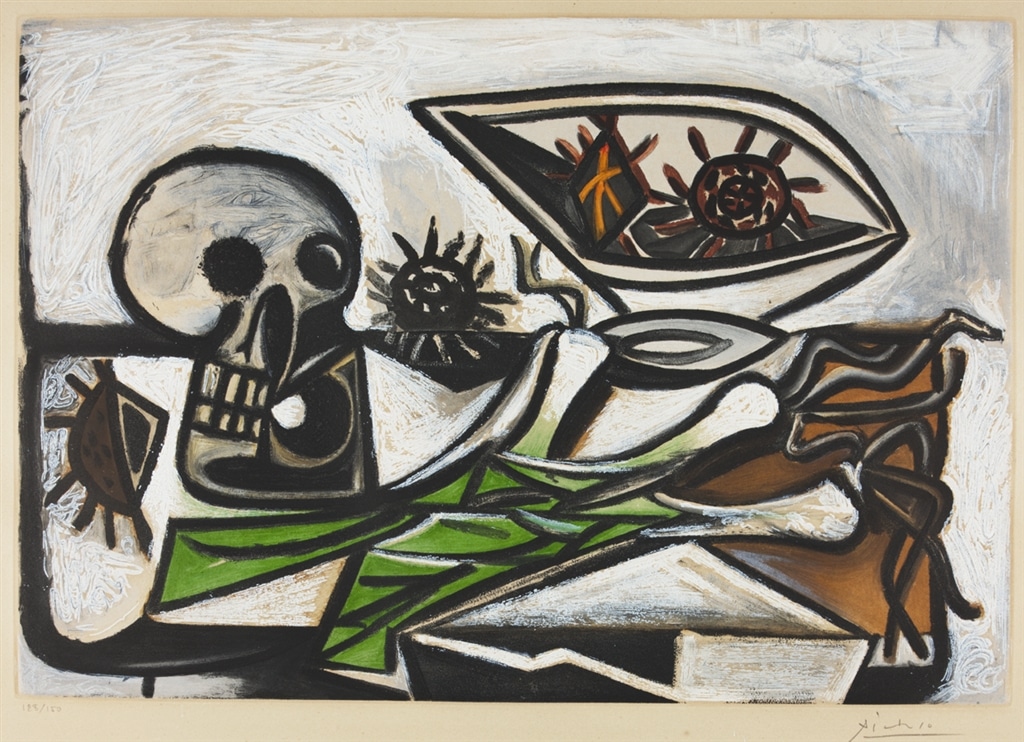
“Nature morte au Crane” (c. 1960), Pablo Picasso
A Fork in the Abstract Road
American art historian Alfred H. Barr Jr. outlines in his 1936 book Cubism and Abstract Art the two divergent paths abstract art took in the early 20th century.
According to Barr, the two main traditions of abstract art are geometrical and non-geometrical.
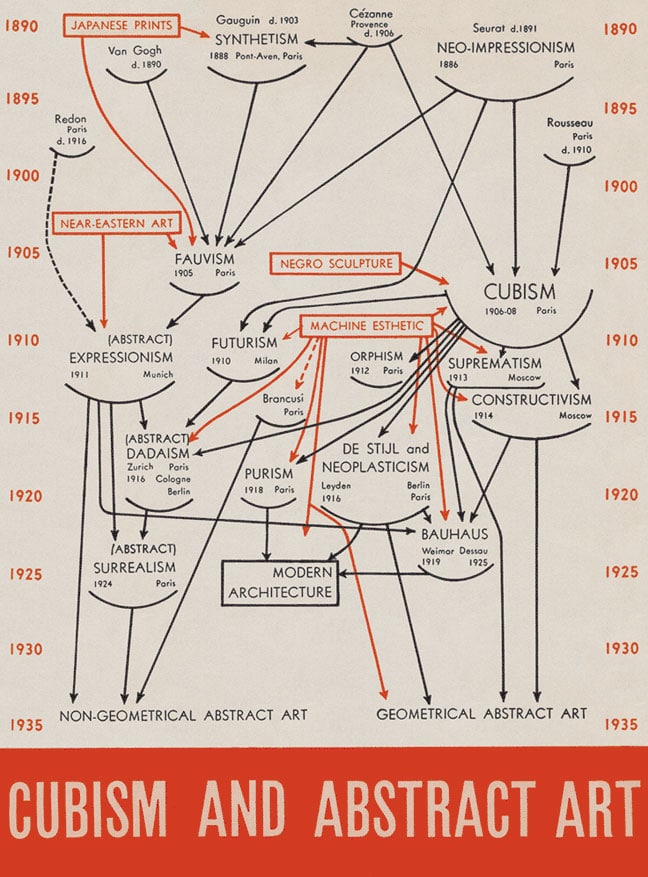
This chart was part of Alfred H. Barr Jr.’s 1936 publication “Cubism and Abstract Art,” which was published by New York’s Museum of Modern Art.
Geometrical abstract art follows Cézanne’s roots in disregarding reality—a tradition embraced by Cubists like Picasso and Georges Braque—to create non-representational artwork that still stresses a “dependence upon logic and calculation.”
Alternatively, non-geometrical abstract art finds freedom in the lack of order, throwing logic and calculation to the wind, all while pushing the limits of form to discover new meanings.
Geometric Abstract Art: Creating Rhyme with a Hint of Reason
While the Cubists deserve their own profile, their influence on abstract artists like Victor Vasarely and his brand of Optical Art can’t be ignored. After becoming fascinated with science at Budapest’s School of Medicine, Vasarely used his optical paintings to try and interpret the physical world.
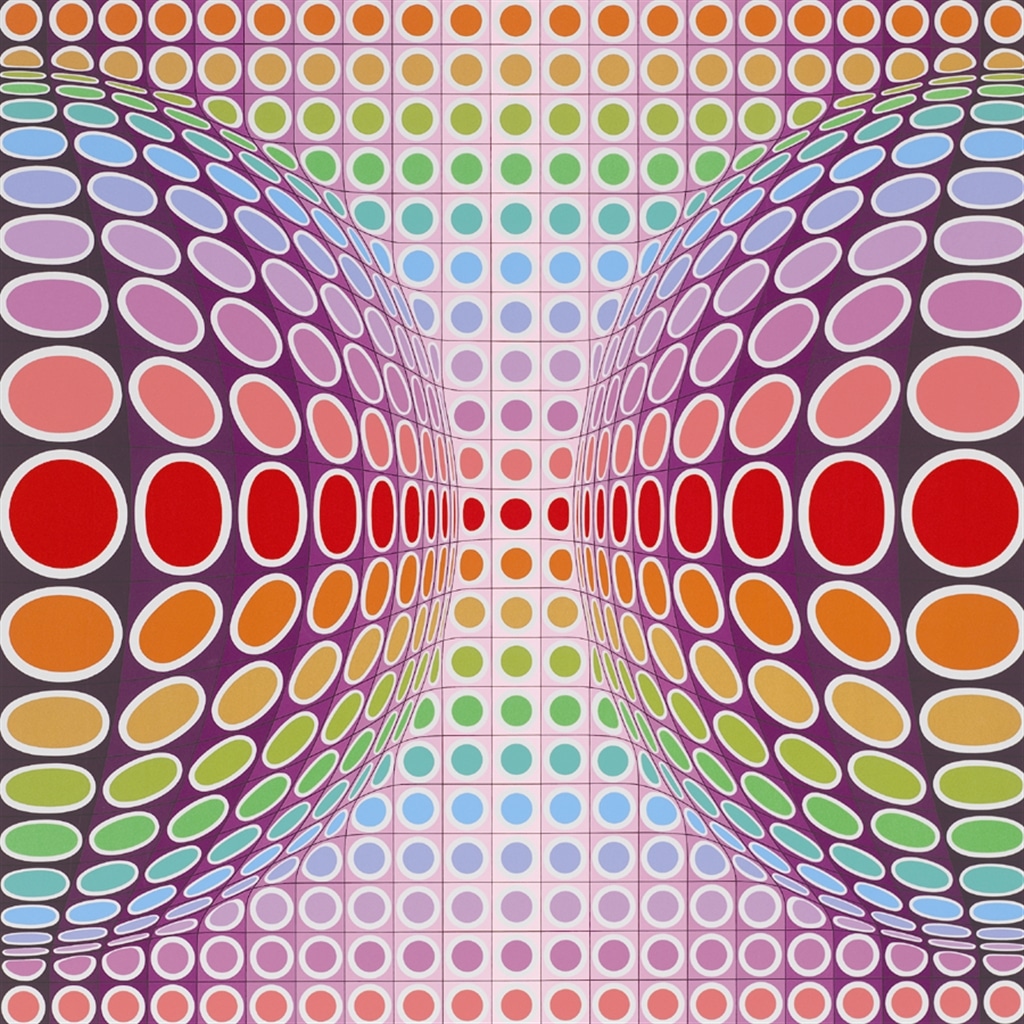
“Dyss” (1989), Victor Vasarely
Vasarely came into popular culture in the 1960s with his widely-circulated Op Art. His heavy reliance on bold, contrasted colors and dizzying patterns left the viewer with a profound sense of energy and movement.
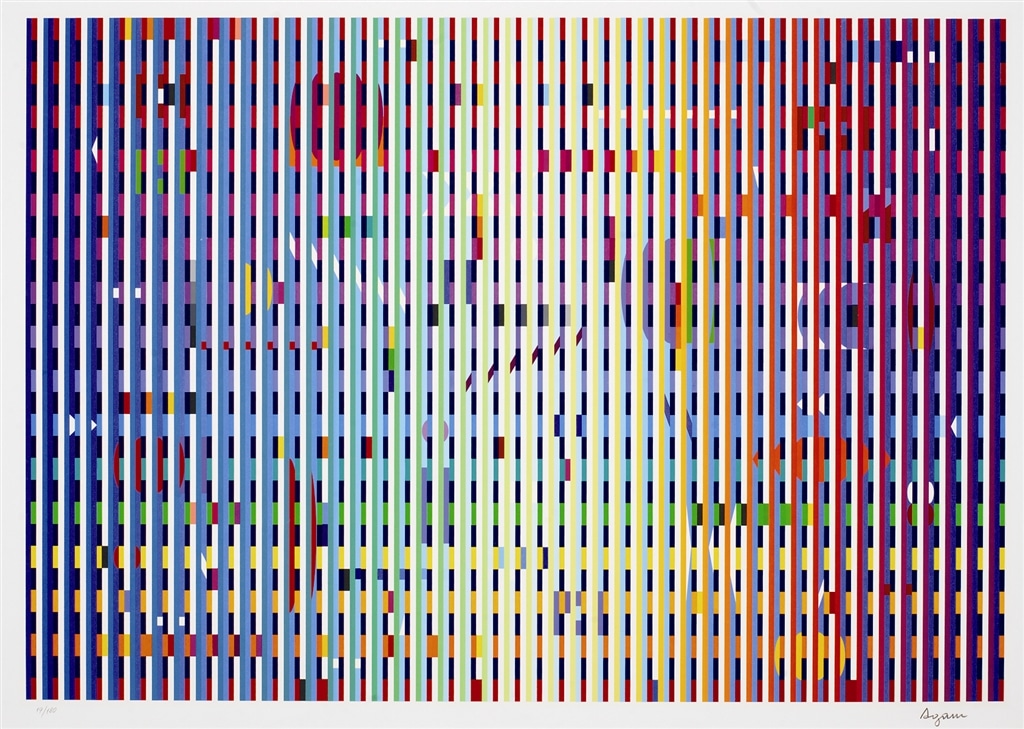
“Rainbow Bright” (2006), Yaacov Agam
With Yaacov and Ron Agam, we see how abstract art can run in the family. Yaacov Agam, one of the contemporary world’s most renowned kinetic artists, uses geometry and sculpture to create radiant patterns that morph and change depending on the angle you view them. In a classical painting of a scene or event, objects and individuals are frozen in time and pose. Yet Yaacov Agam’s constantly-changing and evolving visual patterns convey more than a traditional static painting ever could.
“In life, you look at art and it doesn’t change, but everything changes, but you don’t know how it will change, so you have to go beyond the visible,” Yaacov Agam says. “You have to get the notion that what you see can, at any moment, disappear to be replaced with something else.”
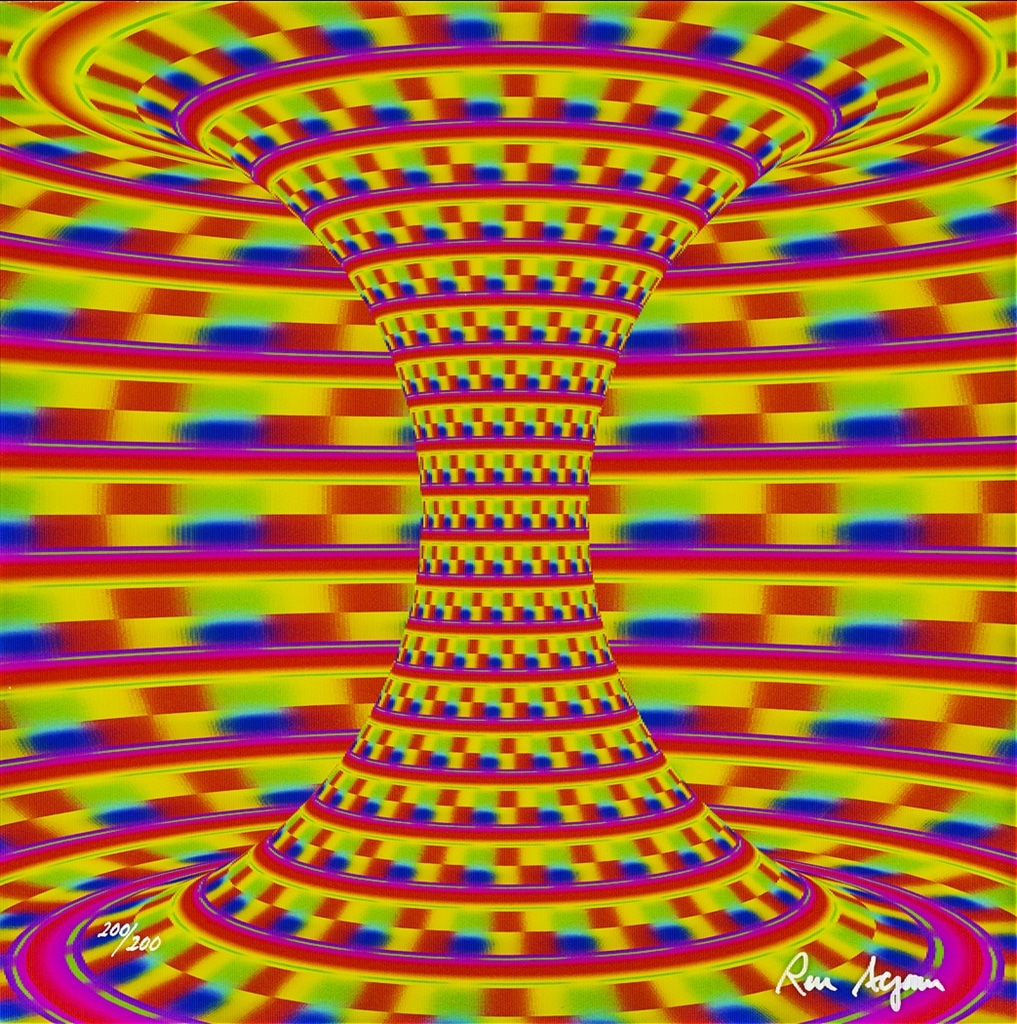
“Hommage to Einstein” (2017), Ron Agam
Thanks to the artistic circles of his father, Ron Agam became infatuated with fine art photography from a young age. After making a successful career as a photographer, Ron decided to follow in his father’s footsteps and began creating his own color-infused, 3-dimensional works. His lenticular compositions are bold enough to even push them into the 4th dimension—time becomes a major factor in how the viewer perceives the artwork, allowing them to get even further drawn in by the work’s abstractions.
Non-Geometric Abstract Art: Releasing the Inner Child
Though typically designated as a Surrealist artist, early 20th-century Spanish artist Joan Miró created a body of work that dives so far into the abstract that it would be a shame to not mention him. Miró’s examinations of the seemingly meaningless patterns of children’s artwork exudes a sense of freedom and joy not often found in traditional art circles.
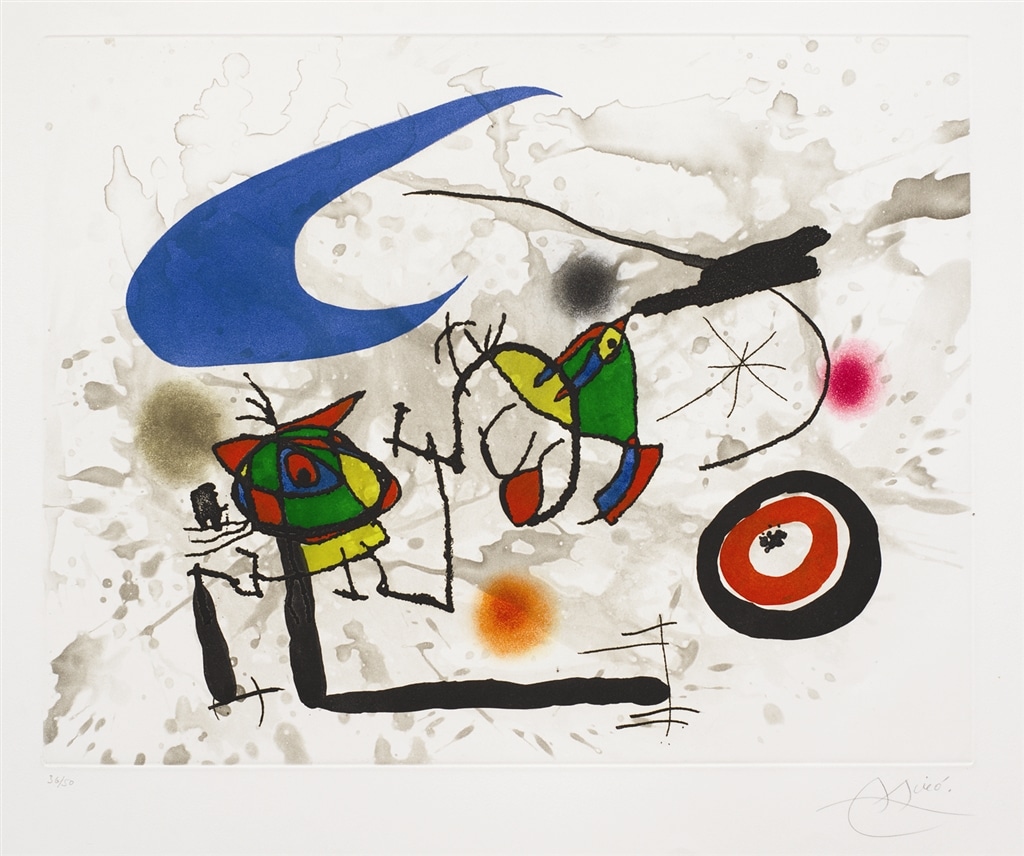
“Pygmies sous la Lune” (1972; d. 562), Joan Miró
In addition to his fascination with early developmental art, Miró also channeled folk art, Spanish religious frescoes, and prehistoric art to inspire emotional responses from his viewer, forcing them to re-consider their role in our fast-paced, regulated world.
As modern technology increasingly attempts to codify and find patterns in art, contemporary artist Dominic Pangborn pushes critics to feel rather than define his ever-changing abstractions. Experimenting with painting at one moment, clay soon after, and graphic design the next, Pangborn keeps the viewer on their toes.
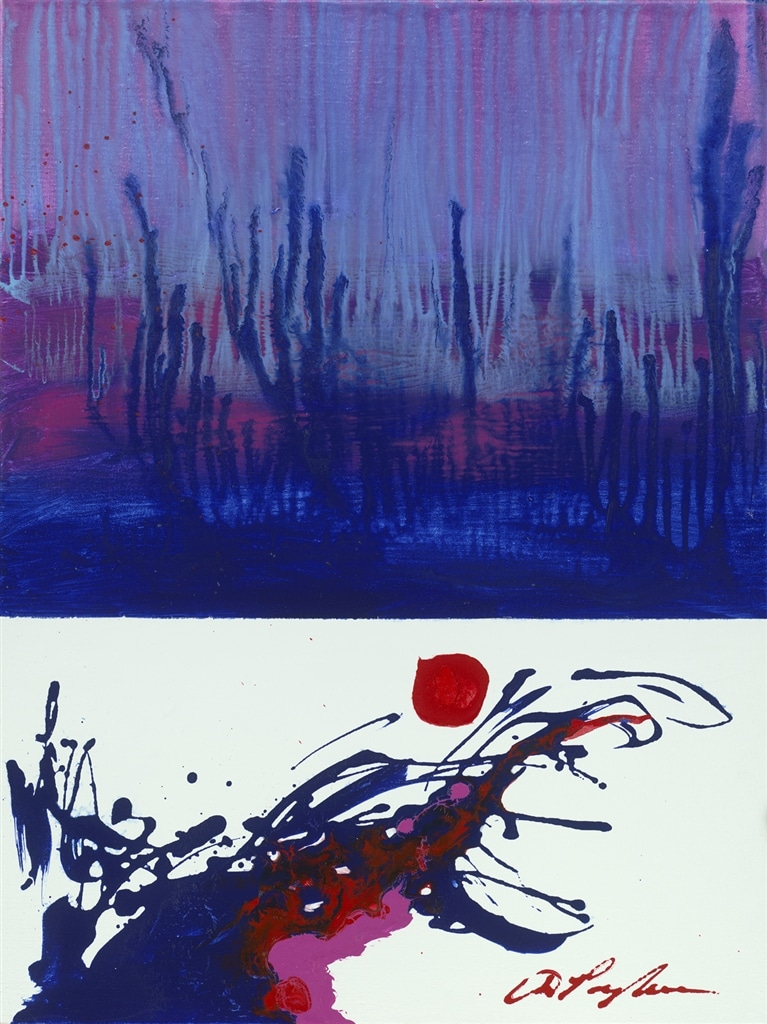
“At Nightfall” (2017), Dominic Pangborn
Similar to Ron Agam’s time-transcending works, Pangborn’s abstract paintings often never have an end goal—instead, he prefers to let his mind wander until a piece is complete.
“I just take the art world in the same way we live our life,” Pangborn says. “Every day the flavor is different, I encounter different situations, I wake up to a different air and so on.”
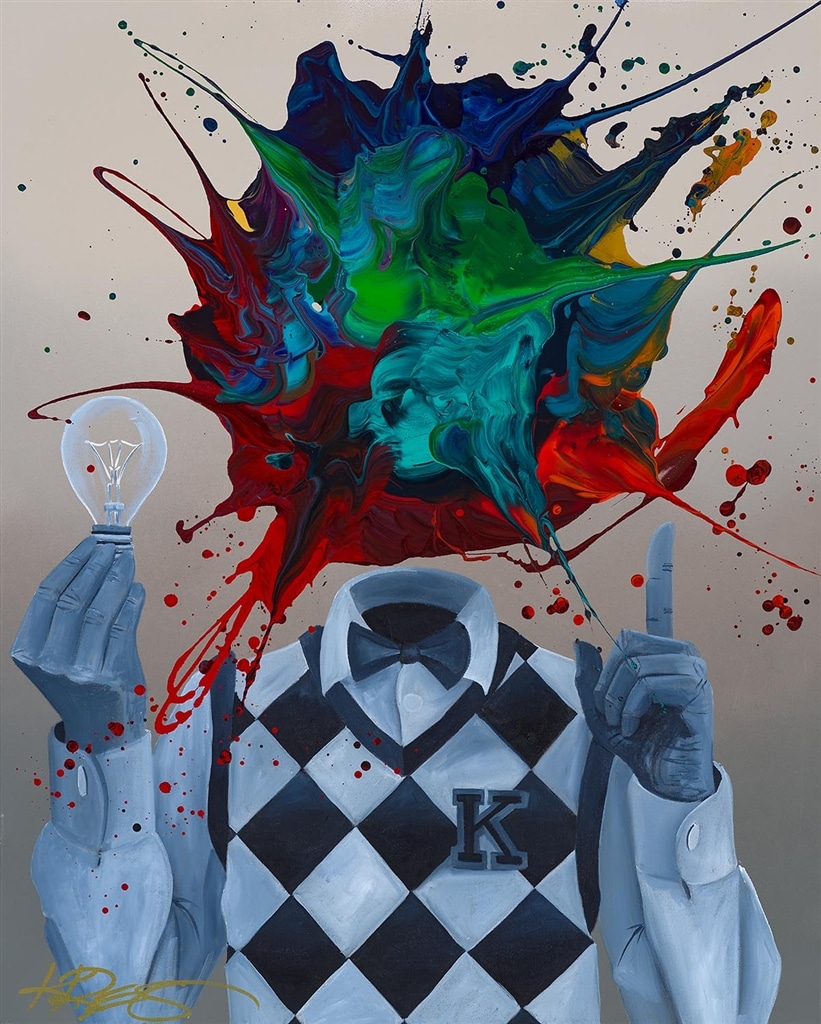
“Knowledge of Self” (2019), Kre8
For 21st-century fans of abstract art, Kevin “Kre8” Vigil’s signature splashes of radiance on black-and-white canvases are recognizable from across the room. His colors fold into one another while still maintaining their individual hues, mesmerizing audiences. Kre8 combines both abstract art and concrete imagery, an artistic style that he’s aptly dubbed “Kre8izm.”
After moving from Berlin at the age of five to the United States, Kre8 struggled to find a place for his early artistic ideas in the uniformity of his school’s art classes. Instead of being discouraged, Kre8 turned to graffiti and tattoo artistry, developing an eye for how colors can play on canvases to convey a feeling rather than concrete shapes.
Despite what skeptical museum-goers might say, Kre8’s juxtapositions of reality and the abstract are incredibly calculated and work to illuminate humanity’s inner creativity.
“The color—the abstract—is us, as people,” he says. “We are the burst of inspiration that’s coming out of the black-and-gray world. No matter how black-and-gray the world is, we still shine.”
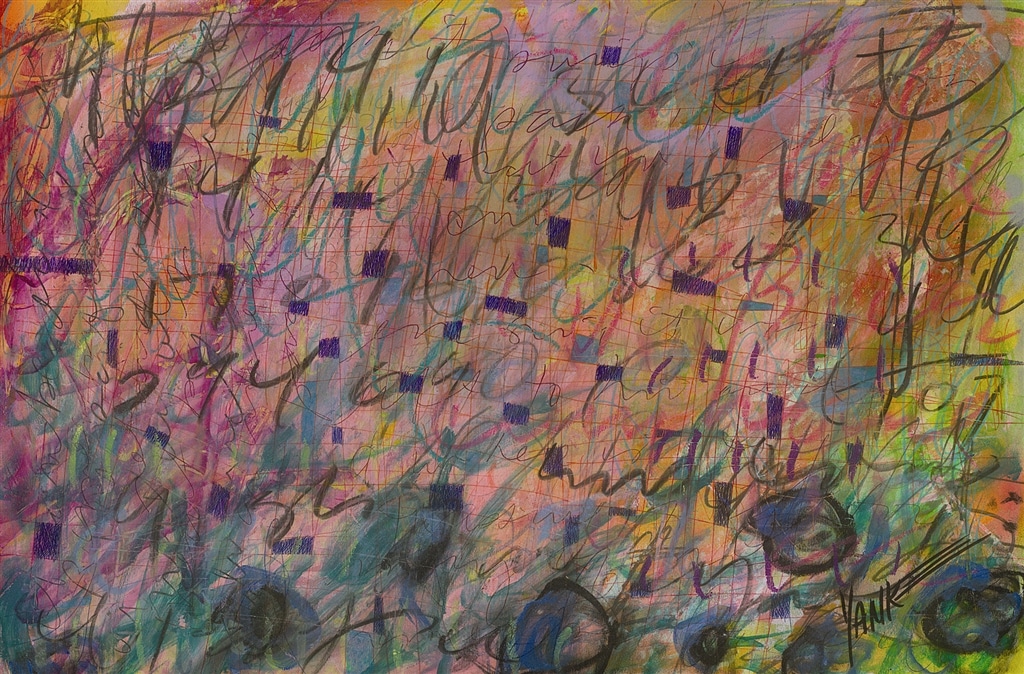
“Living Here” (2008), Tim Yanke
By distancing themselves from the confines of symbols and realism, the Op Art of Vasarely, Miró’s joyous, child-like canvases, and every artist under the abstract sun has found incredibly potent ways to unlock the countless emotions and meanings hiding behind the perceivable world.
Through abstract art, visual art is freed from the shackles of concrete representation and is instead given to everyone for their own interpretations. After all, art is about feeling, not knowing.
If you’re interested in collecting abstract art or want to know more about artists who specialize in abstract art, register for our exciting online auctions or contact our gallery team at 1-800-521-9654, ext. 4 or at sales@parkwestgallery.com.
LEARN MORE ABOUT ART AND ART MOVEMENTS:
- What Is Surrealism? How Art Illustrates the Unconscious
- Chris DeRubeis Talks Abstract Sensualism® and Style
- Discerning Eyes, Abstract Musings: Artist Tim Yanke Comes of Age
- Lebo Breaks Down His Postmodern Cartoon Expressionism
- How Artist Slava Ilyayev Brings Modern-Day Impressionism to Life





